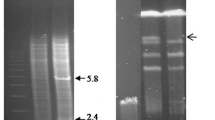Abstract
The cephalosporin C-producing fungus Acremonium chrysogenum was transformed to hygromycin B resistance using different vector constructs. These constructs contain sequences of the pcbC gene from A. chrysogenum, encoding isopenicillin N synthetase. Detailed analysis of transformants, including pulsed-field gel electrophoresis (PFGE), suggests that integration of multiple vector copies takes place predominantly via non-homologous integration. By increasing the length of vector-DNA homologous to genomic DNA, integration occurs more frequently into chromosome VI, carrying the endogencous pcbC gene copy. In gene disruption experiments, the length of vector homology required to obtain cephalosporin C-minus transformants was investigated. Inactivation of the pcbC gene was observed only when homologous fragments of more than 3.0 kb were used on both sites of the resistance cassette. Southern analysis indicated homologous, as well as heterologous, integration of recombinant DNA. The integration of multiple vector copies leads to the appearance of truncated pcbC transcripts.
Similar content being viewed by others
References
Barredo JL, Díez B, Alvarez E, Martín JF (1989) Mol Gen Genet 16:453–459
Binninger DM, Le Chevanton L, Skrzynia C, Shubkin CD, Pukkila PJ (1991) Mol Gen Genet 227:245–251
Buckholz RG, Gleeson MAG (1991) Bio/Technology 9:1067–1072
Case ME (1986) Genetics 113:569–587
Cheevadhanarak S, Renno DV, Saunders G, Holt G (1991) Gene 108:151–155
Durand N, Reymond P, Fèvre M (1991) Curr Genet 19:149–153
Fincham JRS (1989) Microbiol Rev 53:148–170
Gems D, Johnstone IJ, Clutterbuck AJ (1991) Gene 98:61–67
Giasson L, Specht CA, Milgrim C, Novotny CP, Ullrich RC (1989) Mol Gen Genet 218:72–77
Goyon C, Faugeron G (1989) Mol Cell Biol 9:2818–2827
Gritz L, Davies J (1983) Gene 25:179–188
Gutiérrez S, Díez B, Montenegro E, Martín JF (1991) J Bacteriol 173:2354–2365
Gwyn Jones I, Sealy-Lewis HM (1989) Curr Genet 15:135–142
Hasty P, Rivera-Pérez J, Bradley A (1991) Mol Cell Biol 11:5586–5591
Hata Y, Kitamoto K, Gomi K, Kumagai C, Tamura G (1992) Curr Genet 22:85–91
Hoge JHC, Springer J, Zanting B, Wessles JGH (1982) Exp Mycol 6:225–232
Hoskins JA, O'Callaghan N, Queener SW, Cantwell CA, Wood JS, Chen VJ, Skatrud PL (1990) Curr Genet 18:523–530
Hunter GD, Bailey CR, Arst HN Jr (1992) Curr Genet 22:377–383
Isogai T, Fukagawa M, Aramori I, Iwami M, Kojo H, Ono T, Ueda Y, Kohsaka M, Imanaka H (1991) Bio/Technology 9:188–191
Keller NP, Bergstrom GC, Yoder OC (1991) Curr Genet 19:227–233
Khasanov FK, Zvingila DJ, Zainullin AA, Prozorov AA, Bashkirov VI (1992) Mol Gen Genet 234:494–497
Kistler HC, Benny U (1992) Gene 117:81–89
Kück U, Walz M, Mohr G, Mracek M (1989) Appl Microbiol Biotechnol 31:358–365
Le Chevanton L, Leblon G, Lebilcot S (1989) Mol Gen Genet 218:390–396
Lopes TS, Hakkaart G-JAJ, Koerts BL, Raué HA, Planta RJ (1991) Gene 105:83–90
Malmberg L-H, Hu W-S (1992) Appl Microbiol Biotechnol 38:122–128
Mansour SL, Thomas KR, Capecchi MR (1988) Nature 336:348–352
Mathison L, Soliday S, Stepan T, Aldrich T, Rambosek J (1993) Curr Genet 23:33–41
Mézard C, Pompon D, Nicolas A (1992) Cell 70:659–670
Osiewacz HD, Skaletz A, Esser K (1991) Appl Microbiol Biotechnol 35:38–45
Picard M, Debuchy R, Julien J, Brygoo Y (1987) Mol Gen Genet 210:129–134
Punt PJ, Greaves PA, Kuyvenhoven A, van Deutekom JCT, Kinghorn JR, Pouwels PH, van den Hondel CAMJJ (1991) Gene 104:119–122
Queener SW, Ingolia TD, Skatrud PL, Chapman JL, Kaster KR (1985) A system for genetic transformation of Cephalosporium acremonium. In: Leive L (ed) Microbiology-1985. American Society for Microbiology, Washington D.C., pp 468–472
Razanamparany V, Bégueret J (1988) Gene 74:399–409
Sakai A, Shimizu Y, Hishinuma F (1990) Appl Microbiol Biotechnol 33:302–306
Sambrook J, Fritsch EF, Maniatis T (1989) Molecular cloning: a laboratory manual. Cold Spring Harbor Laboratory, Cold Spring Harbor, New York
Schiestl RH, Petes TD (1991) Proc Natl Acad Sci USA 88:7585–7589
Selker EU, Cambareri EB, Jensen BC, Haack KR (1987) Cell 51:741–752
Shen P, Huang HV (1986) Genetics 112:441–457
Skatrud PL, Queener SW (1989) Gene 78:331–338
Skatrud PL, Queener SW, Carr LG, Fisher DL (1987) Curr Genet 12:337–348
Skatrud PL, Tietz AJ, Ingolia TD, Cantwell CA, Fisher DL, Chapman JL, Queener SW (1989) Bio/Technology 7:477–485
Smith AW, Ramsden M, Peberdy JF (1992) Gene 114:211–216
Smith DJ, Bull JH, Edwards J, Turner G (1989) Mol Gen Genet 216:492–497
Stauffer JF, Schwartz LJ, Brady CW (1966) Dev Ind Microbiol 7:104–113
Steele PE, Carle GF, Kobayshi GS, Medoff G (1989) Mol Cell Biol 9:983–987
Struhl K (1983) Nature 305:391–397
Struhl K, Cameron JR, Davies RW (1976) Proc Natl Acad Sci USA 73:1471–1475
Tsukuda T, Carleton S, Fotheringham S, Holloman WK (1988) Mol Cell Biol 8:3703–3709
Waldron C, Murphy EB, Roberts JL, Gustafson GD, Armur SL, Malcom SK (1985) Plant Mol Biol 5:103–108
Walz M (1992) Bibl Mycol 147
Walz M, Kück U (1991) Curr Genet 19:73–76
Ward M, Wilson LJ, Kodama KH, Rey MW, Berka RM (1990) Bio/Technology 8:435–440
Whitehead MP, Gurr SJ, Grieve C, Unkles SE, Spence D, Ramsden M, Kinghorn JR (1990) Gene 90:193–198
Author information
Authors and Affiliations
Additional information
Communicated by K. Wolf
Rights and permissions
About this article
Cite this article
Walz, M., Kück, U. Targeted integration into the Acremonium chrysogenum genome: disruption of the pcbC gene. Curr Genet 24, 421–427 (1993). https://doi.org/10.1007/BF00351851
Received:
Issue Date:
DOI: https://doi.org/10.1007/BF00351851




